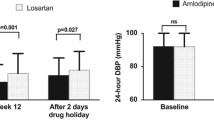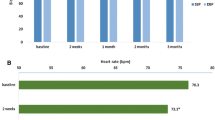Summary
The antihypertensive effects of once-daily diltiazem CD over a 24 hour period were compared with twice-daily diltiazem SR in 95 patients with mild to moderate hypertension using ambulatory blood pressure monitoring. This trial was designed as a multicenter, double-blind, parallel-group study. Following a 2 to 4 week placebo run-in period, diltiazem was administered as once-daily CD or twice-daily SR, starting with 180 mg daily and increasing to a maximum of 360 mg daily, to achieve a seated diastolic blood pressure goal of ≤90 mmHg as measured by cuff between 08:00 and 10:00 in the morning. Following drug titration, patients received a maintenance dose of diltiazem for an additional 6 week follow-up phase. Twenty-four hour ambulatory blood pressure monitoring recordings were obtained at the end of the placebo, titration, and maintenance phases. Both diltiazem CD and diltiazem SR significantly reduced both systolic and diastolic blood pressure over the 24 hour day and maintained a normal circadian pattern. As well, treatment with once-a-day diltiazem CD significantly decreased the slope of the early morning rise of diastolic and mean blood pressure. Thus, diltiazem CD is as effective as diltiazem SR in lowering diastolic blood pressure over a 24 hour period and has the advantage of a once-daily formulation.
Similar content being viewed by others
References
Buckley MM-T, Grant SM, Goa KL, McTavish D, Sorkin EM. Diltiazem: A reappraisal of its pharmacological properties and therapeutic use.Drugs 1990;39:757–806.
Materson BJ, Reda DJ, Cushman WC, et al. Single-drug therapy for hypertension in men. A comparison of 6 antihypertensive agents with placebo.N Engl J Med 1993;328:914–921.
Frishman W, Kirkendall W, Lunn J, et al. Diuretics versus calcium-channel blockers in systemic hypertension: A preliminary multicenter experience with hydrochlorothiazide and sustained-release diltiazem.Am J Cardiol 1985;56:92H-96H.
Massie B, McCarthy P, Ramanathan K, et al. Diltiazem and propranolol in mild to moderate essential hypertension as monotherapy or with hydrochlorthiazide.Ann Intern Med 1987;107:150–157.
Ferdinand K, Baribian GS, Bregman H, Judelson D. The safety and efficacy of sustained-release diltiazem.Pract Cardiol 1990;16:3–11.
Frishman WH, Zawada ET, Smith LK, et al. Comparison of hydrochlorothiazide and sustained-release diltiazem for mild-to-moderate systemic hypertension.Am J Cardiol 1987;59:615–623.
Pool PE, Herron JM, Rosenblatt S, et al. Metabolic effects of antihypertensive therapy with a calcium antagonist.Am J Cardiol 1988;62:109G-113G.
Data on file. Nordic Merrell Dow.
O'Brien E, O'Malley K, Cox J, Stanton A. ABPM in the evaluation of drug efficacy.Am Heart J 1991;121:999–1006.
Ruddy TD, Wright JM, Savard D, Handa SP, Chockalingam A, Boulet AP. Comparison of the efficacy of once daily vs twice daily formulations of diltiazem in the treatment of systemic hypertension.Cardiovasc Drugs Ther 1995;9:413–420.
O'Brien E, Mee F, Atkins N, O'Malley K. Accuracy of the SpaceLabs 90207 determined by the British Hypertension Society.J. Hypertens 1991;9:573–574.
O'Brien E, Atkins N, Mee F, O'Malley K. Comparative accuracy of six ambulatory devices according to blood pressure levels.J Hypertens 1993;11:673–675.
Streitberg B, Meyer-Sabellek W. Smoothing twenty-four-hour ambulatory blood pressure profiles: A comparison of alternative methods.J. Hypertens 1990;8(Suppl 6):S21-S27.
Pullar T, Birtwell AJ, Wiles PG, Hay A, Feely MP. Use of a pharmacologic indicator to compare compliance with tablets prescribed to be taken once, twice or three times daily.Clin Pharmacol Ther 1988;44:540–545.
Millar-Craig MW, Bishop CN, Raftery EB. Circadian variation of blood pressure.Lancet 1978;1:795–797.
Sirgo MA, Mills RJ, De Quattro V. Effects of antihypertensive agents on circadian blood pressure and heart rate patterns.Arch Intern Med 1988;148:2547–2552.
Marsh EE, III, Biller J, Adams HP Jr, et al. Circadian variation in onset of acute ischemic stroke.Arch Neurol 1990;47:1178–1180.
Muller JE, Tofler GH, Stone PH. Circadian variation and triggers of onset of acute cardiovascular disease.Circulation 1989;79:733–743.
Willich SN, Levy D, Rocco MB, et al. Circadian variation in the incidence of sudden cardiac death in the Framingham Heart Study population.Am J Cardiol 1987;60:801–806.
Author information
Authors and Affiliations
Consortia
Additional information
See appendix for list of participants.
Rights and permissions
About this article
Cite this article
Ruddy, T.D., Wright, J.M., Savard, D. et al. 24 hour blood pressure control with once-daily versus twice-daily formulations of diltiazem. Cardiovasc Drug Ther 9, 799–807 (1995). https://doi.org/10.1007/BF00879874
Received:
Accepted:
Issue Date:
DOI: https://doi.org/10.1007/BF00879874




